Conversion funnels are commonly used marketing and business analysis tools. They help brands understand how effective their marketing is, how to improve sales, and much more. Yet many product and UX teams aren’t sure how to use conversion funnels, let alone how to create ones that serve their needs.
In this article, we’ll explain what a conversion funnel is, describe how to create a conversion funnel for your brand, and demonstrate how to analyze your organization’s conversion funnel for continuous improvements.
While conversion funnels are used across product, UX, and other teams, we’ll be discussing them in the context of marketing.
What is a conversion funnel?
In a nutshell, a conversion funnel is a distillation of the buyer’s journey. The journey begins when a visitor discovers your brand or a specific product and ends when the visitor abandons the process or “converts” into a paying customer or buyer.
Conversion funnels are often used to illustrate marketing concepts to team members and organize conversion plans. Due to these goals, many conversion funnels are divided into distinct stages:
The “top-of-funnel” (or “TOFU”) is the broadest part of the funnel because it represents the greatest number of people. For example, every brand can expect to get more website visitors than it gets actual, paying customers from its website conversion funnel.
The “middle-of-funnel” (or “MOFU”) includes most of the stages of the consumer’s journey.
The “bottom-of-funnel” (or “BOFU”) describes the endpoint of the funnel when a visitor converts into a paying customer. It’s the narrowest part of the funnel because it’s the section that the fewest visitors reach (for a variety of reasons).
At the top of the funnel, users begin to research products or brands. They might be unsure about what they need, or whether a company is right for their purposes. In the middle of the funnel, a visitor or user considers whether to make a purchase. At the bottom of the funnel, a visitor either makes a purchase or abandons the funnel for one reason or another.
The ultimate goal of every company is to maximize how many people proceed down the conversion funnel from start to finish. Certain factors, such as brand awareness, company reputation, or a brand’s relationship with a consumer, may shorten the funnel journey.
Why are conversion funnels important?
Conversion funnels are important because:
They can help your marketing team be more effective
They help to illustrate the customer journey, which can be important for understanding how your visitors navigate your site/store
They can break down which stage of the buyer’s journey has the most failure
All of these elements are important for boosting your brand’s conversion rate. Conversion rate is the proportion of visitors or users you have compared to buyers or subscribers. A 20% conversion rate means that 20% of all visitors to your store buy something or subscribe.
When you use a marketing conversion funnel, you can determine, for instance, what stage of the buyer’s journey is most problematic. Are most of your visitors abandoning the conversion funnel at the top? That may indicate a problem with your website landing page or brand reputation.
Alternatively, maybe most of your users abandon the conversion funnel near the bottom. That could mean there’s a problem with the checkout conversion process or that your product copy isn’t converting users into customers effectively.
Further reading: Take a look at Fullstory's Funnels & Conversions feature
What is a good conversion rate?
While a higher conversion rate is always ideal, there’s no universal “good” conversion rate for every brand.
For example, if you only have 10 customers but a conversion rate of 100%, you have an excellent conversion rate, yet low sales.
That means your company needs to identify the best conversion rate for its purposes. To do this:
Quantify your past data and establish a historical baseline conversion rate based on prior company performance or visitor habits
Determine how much revenue you need to earn to be in the black or to accomplish other budgetary objectives
Then prioritize improving conversion rate by bolstering the conversion funnel’s effectiveness and efficiency
Again, any conversion rate improvement is good. But there’s no single target you should aim for.
For instance, if your brand is in a highly technical field, it’s logical to assume you’ll have only a few customers. And if your brand sells expensive products or services, just a few customers could be enough to ensure business longevity and financial stability.
Plus, you may be less reliant on a very high conversion rate if you rely primarily on subscribers or repeated income. If you run a software as a service or SaaS company, for example, retaining customers is more important than getting a high conversion rate. In theory, once you convert a customer, you'll keep them for months or years to come.
The five (main) elements of a conversion funnel
Traditionally, conversion funnels consist of five main elements. However, depending on the organization you work for, your company’s conversion funnel may have fewer or more stages. Regardless, conversion funnels must include the below steps to represent a complete buyer’s journey.
Let’s take a look at these main elements of a conversion funnel one by one.
1. Awareness
Awareness includes attracting customers to your brand or making your target audience members aware of your company. During the awareness stage, your company pulls customers in via marketing efforts, reputational improvements, or other means of boosting brand awareness.
Generally, the most successful companies don't rely on just one element of marketing strategy. Instead, they leverage multiple marketing channels, oftentimes connecting them to omnichannel marketing tactics. In this way, it's possible to reach a wider audience more effectively than otherwise.
Some examples of marketing to improve customer awareness include:
Online ads, such as PPC ads
Affiliate marketing
Blogs and organic search
Radio ads or TV ads
Print ads
Podcasts
Social media marketing
Video marketing on YouTube and other platforms
No matter what marketing method your company uses, a successful end to this stage means a visitor reaches your conversion funnel by approaching your main conversion touchpoint.
However, it’s important to note that potential customers can enter your company’s conversion funnel without any effort on your part. They can do this if they decide they need a product or service you provide.
For example, if a potential customer realizes they need a product your company creates, they have technically entered the awareness stage of the marketing funnel whenever they learn of your brand and its products.
Remember, as the uppermost stage of the conversion funnel, the awareness stage captures most traffic.
2. Interest
The next stage is even more important. Dubbed the “interest” or consideration phase, it’s here that you try to build trust and desire with your prospects or leads. It’s not enough for prospective customers to know that your brand makes products they can use. They have to choose your brand from all the competing companies or brands in the industry.
The interest stage is significantly affected by things like:
The type of content you make on your social media channels and website
Your brand reputation, which may make it more likely that a potential customer will engage with your company
Your social media marketing
Everything about your brand and its marketing can come into play here once again. If your marketing is positive and does a good job of connecting with potential buyers, more visitors from the awareness stage will make it to the interest stage without a lot of lead bleeding.
3. Desire
During the “desire” phase, your brand must drive potential buyers’ interest and show them why they should purchase your product instead of another brand’s
In this phase of the conversion funnel, it's important to leverage attention-grabbing elements, like:
Phenomenal product descriptions for every item on your online store
Excellent images, such as enticing photos
Videos of products or services where applicable
Downloadables like whitepapers and case studies
Good product and website copy
Excellent social media influencing
And more
If your brand already has some sales, your company should leverage positive reviews to encourage new customers to buy your products. You can also increase desire through ancillary strategies, like:
Offering free shipping, which could make your brand more attractive relative to alternatives
Generous promotional offers, such as discounts
Content marketings that provides helpful or informative content and improve brand authority in the industry
Bottom line: the point of this phase of the conversion funnel is to convince prospective customers to become real customers by interesting them.
4. Conversion
At the conversion stage of the funnel, things have begun to narrow significantly. It’s time to convert leads into customers. Note that some conversion funnel graphics or descriptions may mark this stage as the last one.
Also sometimes called the action stage, the conversion stage is met when a customer makes a purchase or subscribes to your brand. It can also include other forms of conversion, like signing up for a newsletter.
The bottom of your sales funnel should include a call to action, making a sale, or otherwise extracting value from a lead/visitor. You can improve the likelihood of prospects reaching this phase of the conversion funnel by:
Using excellent email marketing strategies, if conversion rate refers to email sign-ups
Streamlining the checkout process to remove distracting elements
Using A/B testing where applicable
Offering free or discounted shipping to sweeten the deal
5. Re-engage
Technically, there’s a fifth and final stage of a successful conversion funnel: re-engagement. Also known as the loyalty stage, this final stage occurs after a lead becomes a customer or subscriber.
But it’s almost always better to retain current customers than constantly attract new ones. You want current customers to re-engage and buy more products or stay subscribed. This improves the customer lifetime value or CLV of each customer for your brand.
Even better, when a customer proceeds even further down the conversion funnel, they don’t enter back at the top. Instead, they already know and trust your brand and proceed straight to the third or fourth stage of the buyer’s journey. Less time spent in the funnel means a higher likelihood of each visitor making another purchase.
How to create an effective conversion funnel
While conversion funnels can be effective, you need to know how to create one that represents your buyer’s journey accurately. Let’s break down how to create a conversion funnel step-by-step.
Determine your ideal buyer journey and map it out as a funnel
First, you must determine your ideal buyer’s (sometimes called the target audience member or customer avatar) journey. Then you can map that journey out as a funnel-shaped object.
Think of customer journey maps as visualizations of a potential customer’s engagement or experience with your brand. The more detailed and plotted they are, the better you’ll understand the mindset of your target customers. Buyer journey maps are useful since they can help:
Promote a customer-centric culture for your company
Improve sales conversion rates
Identify your ideal buyer
Connect with customer needs
Optimize with marketing campaigns
Generate repeat customers more consistently
Every customer journey map is different, based on the unique characteristics or needs of that customer. For example, imagine that your brand sells products to highly technical
While many common customers do a minimum of research or review checking before buying, these technical professionals will probably do much more research. If you know this, you can add it to your buyer journey and include it in your marketing or website design.
Set goals for each funnel stage
After mapping out a buyer journey, you should set the goals for every stage in your conversion funnel. You should have goals for the top, middle, and bottom stages. Here are some examples of goals for every final stage based on their locations:
Top-level goals should include a higher click-through rate for your PPC or other ads, more time spent on page, or more mentions on social media
Middle-level goals should include a higher add to cart rate (see more below), more time spent on-page, and more page visits for your site
Low-level goals should include a higher conversion rate, a low shopping cart abandonment rate, and similar improvements
By identifying these goals, you can set specific metrics for your marketing or conversion funnel team and act accordingly.
Implement strategies and create content to generate awareness
After identifying your goals, implement strategies to reach those goals. Simultaneously, your brand should create lots of content, including ads and blog posts, to generate awareness for your target audience members.
The more awareness you generate, the likelier that target audience members will visit your brand and enter the conversion funnel.
Generate interest and desire
As your brand generates interest and desire through influencer marketing, social media marketing, online marketing, and other elements, you'll generate interest in your products and services. This will also generate a desire for those products.
It’s important to stoke that interest and desire by:
Creating a streamlined, smooth user experience on your site/store
Making it easy for customers to add things to their carts
Offering responsive customer service when needed
Encourage users to take action
Then you need to encourage your site’s users to take your desired action. For example, if you want to boost conversion for email marketing sign-ups, you can and should add a call to action or CTA to the popup or checkout page where you offer that newsletter.
Calls to action should also be resident on your ads and at the bottom of each product page at your online store. Other means to encourage your users to take action include:
Requesting demos of software or services
Sending actionable emails through email marketing
Including customer testimonials on your site/checkout page to convince visitors to convert
What is conversion funnel optimization?
Conversion funnel optimization means streamlining, improving, or otherwise boosting your conversion funnel for better conversion at each stage and overall. For example, you might optimize your conversion funnel by maximizing customer awareness of your brand, improving how many people go to stage 2 of your funnel. Conversion funnel optimization is a type of conversion rate optimization.
It’s a good idea to optimize your funnel so you can benefit from:
Increased customer awareness
More sales and revenue
More efficient marketing, which also means more saved money through eliminating inefficient marketing methods
Better customer relationships and industry reputation
In other words, optimizing your conversion funnel leads to net benefits for your brand in many more ways than one.
Conversion funnel optimization is related to conversion rate optimization.
How to optimize your conversion funnel
There are many ways you can optimize your company’s conversion funnel. However, different strategies are best utilized for different stages of your funnel.
For example:
Lower funnel stages are primarily about building trust and improving customer experiences and satisfaction with products. Your optimization strategies should lean heavily into demonstrating the benefits of your brand or products and building trust with leads to convince them to buy.
Middle funnel strategies should be about driving traffic to your site and specific products, creating personalized or targeted experiences, and convincing customers to buy from you rather than a competitor.
Top-of-the-funnel stages are about bringing people to your brand in the first place. Optimization efforts heavily rely on marketing improvements and utilizing keywords smartly, and leveraging APIs like the Google SERP API can enhance your keyword strategy by providing insights into search engine result pages.
Examine your conversion funnel and determine which stage(s) needs the most work. Then you can implement optimization efforts like:
Making your website easier to navigate through improved UI
Improving product copy or product images
Analyzing heatmaps, scroll maps, or other engagement maps to understand what’s working and what’s not
Making it easier to check out from your store
Offering free or discounted shipping
Improving your social media or online ads
How to read a conversion funnel analysis
What is your conversion funnel analysis telling you and what should you do about it?
Conversion funnel analysis involves looking at how your current funnel performs and determining how you can improve it overall. This analysis is often complemented by a broader understanding of the end-to-end customer experience, which customer journey mapping tools are designed to help dissect and visualize.
Using custom-gathered data, product analytics, or a behavioral data platform like Fullstory, you can look at each stage in your conversion funnel and determine:
How many customers reach every stage of the funnel
What percentage of customers leave the conversion funnel at each stage
What steps you can take to increase the number of visitors or customers who proceed further down the funnel than before
For example, you might analyze your conversion funnel and find that you lose most leads in the middle, during the desire stage. That tells you:
Your marketing efforts are doing a great job bringing people to your site
But something about your site or products isn’t swaying most visitors to make a purchase
Armed with this information, you can then make significant changes to that stage of the buyer’s journey and see a better conversion rate as a result. For example, you can:
Add more attractive pictures to each product
Change the copy within product descriptions to be more attractive
Streamline or simplify the checkout process to reduce cart abandonment
All in all, it’s a good idea to analyze your brand’s conversion funnel regularly. That’s the best way to keep tabs on how it’s performing and to make rapid changes when necessary. Conversion funnel analysis is an ongoing process you should never stop doing.
Most brands should analyze their conversion funnel monthly at the latest. The more you analyze, the better tabs you’ll have on your audience mindset and the performance of your online marketing.
What are the most important KPIs when measuring a conversion funnel?
How can you know if your conversion funnel is streamlined and effective? For many brands, it means measuring critical KPIs or key performance indicators. Key performance indicators tell you specific things about your products, customers, conversion rate, and more. Here are some of the most crucial KPIs to measure when analyzing your conversion funnel and its performance.
Repurchase rate
The repurchase rate is a percentage of happy customers who make more than one purchase within a set time period, like one week or one month. For example, if half of your customers make at least two purchases in the first quarter of your fiscal year, you have a repurchase rate of 50%.
Repurchase rate can be used as a useful proxy to determine how well customers like your brand and how likely they are to remain long-term customers rather than switching to another brand.
Retention rate
Retention rate is related to repurchase rate. It’s a percentage-based representation of how many customers you retain after they make at least one purchase. For instance, if 40 out of 100 customers make at least two purchases within a month, you have a retention rate of 40% for that month.
However, retention rate is more often used to measure consistent subscribers for subscription-based businesses or services. For instance, if you initially get 100 subscribers, but only 50 subscribers stay subscribed at the end of that month, your retention rate is 50%.
Average order value
Average order value or AOV tells you how much money, on average, a typical customer spends at your business. This can be a great way to estimate or predict long-term revenue for your brand, presuming purchases or subscriptions remain consistent.
With this information, you can decide whether you should increase or decrease prices or take other steps to stabilize revenue streams.
Customer lifetime value
Customer lifetime value or CLV breaks down how much money the average customer is expected to spend at your brand. It’s a great way to determine whether you need to double down on customer retention (if CLV is very high) or if you should prioritize acquiring new customers (if CLV is quite low) to maximize revenue.
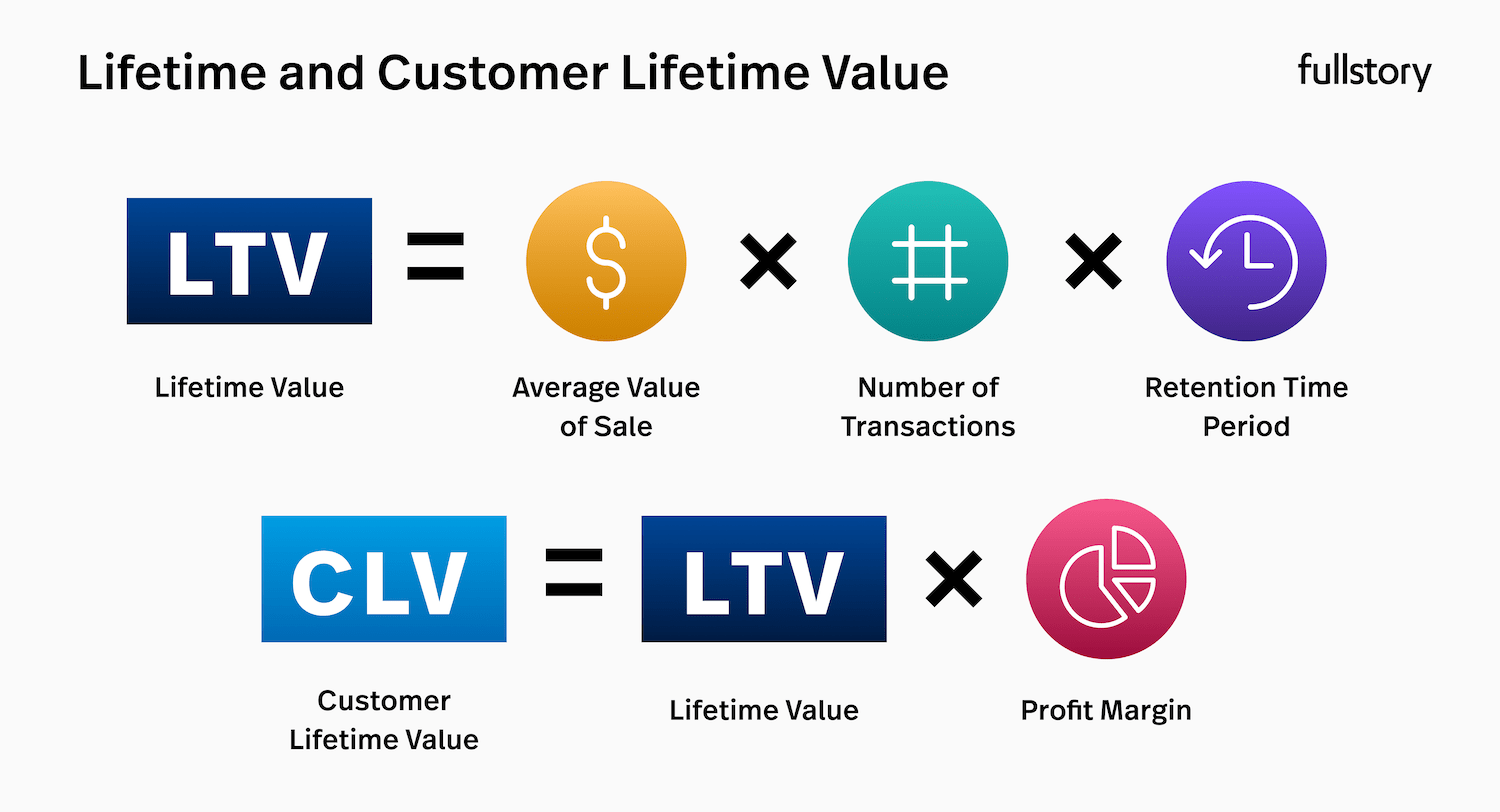
Add to cart rate
The add-to-cart rate tells you the percentage of site visitors who add products to digital shopping carts. This is a useful proxy for telling you how effective your conversion funnel is up until stage 4, conversion, as it tells you:
How attractive your products are
How streamlined your website is
How easy it is for customers to add products to their carts
Read more: Understanding conversion rates using Fullstory
Cart abandonment rate
Cart abandonment rate is the opposite. It tells you the percentage of site visitors who abandon shopping carts with at least one item inside. A high cart abandonment rate means that customers are interested enough in your brand to consider making a purchase, but aren’t interested enough to seal the deal.
That could mean you need to work on:
Your checkout page
Your shipping policy
Your product prices
Something else entirely
Click conversion rate
Click conversion rate is the number of conversions your brand receives divided by how many clicks your brand receives, expressed as a percentage. It's used to determine the effectiveness of PPC or pay-per-click ads since it tells you which ads generate the most conversions after someone clicks on them.
Conversion rate
Lastly, the overall conversion rate is the percentage of site visitors who “convert” into customers or subscribers. A higher conversion rate is always better since it means more people are engaging with your brand or making purchases.
How Fullstory helps you track conversion funnels, identify problems, and find opportunities for improvement
Conversion funnel creation and analysis are incredibly important for the success of your company. That's why Fullstory is an industry-leading funnel software tool right out of the box. As a funnel analysis tool, Fullstory offers flexible, instrumentation-free, and powerful means to solve major problems with conversion funnels and optimize workflows.
For example, Fullstory:
Allows you to analyze visited URLs and track all other user interactions you may wish to examine/understand. Fullstory Funnels enables in-depth analysis for all captured data on your site and indexes it for easy searching and organizing
Provides at-a-glance quantitative insights, such as trends over daily, weekly, and/or monthly users, information about the behaviors of top users, and more
Provides funnel examples for analysis or practice
Diagnoses and optimizes conversion funnels using Session Replay tools
Fullstory is much more in-depth and robust than other conversion funnel analysis tools. For example, Fullstory allows you to create “hybrid” funnels, merging customer events and URL clicks together for a full understanding of consumer behaviors and habits.
With Fullstory, you can create funnels fully customized and perfectly tailored to your brand and target audience. With Fullstory’s funnels, you can view and track completion rates, drop-off rates, and many more metrics and KPIs based on your marketing team's needs.
When you dive into Fullstory, you can check out metrics like:
Users, which is the total number of users who started in one of your created funnels for a specified timeframe
File conversion rate, which breaks down the percentage of users that completed the funnel or a file stage
The median time to convert, which shows you how long it takes for users to complete your conversion funnel on average
You can also watch session replays to see how and wny your users are engaging with your product the way they are.
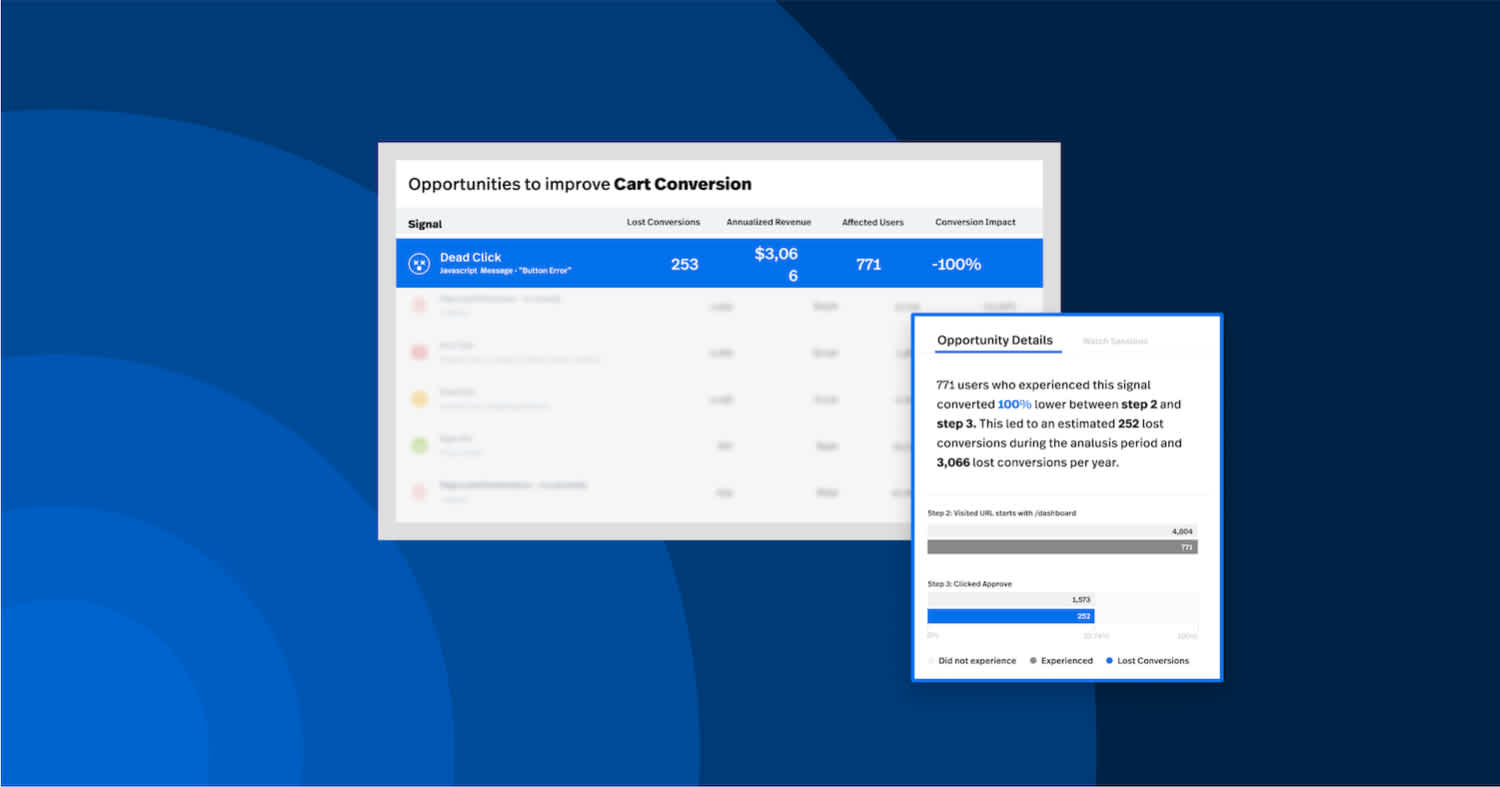
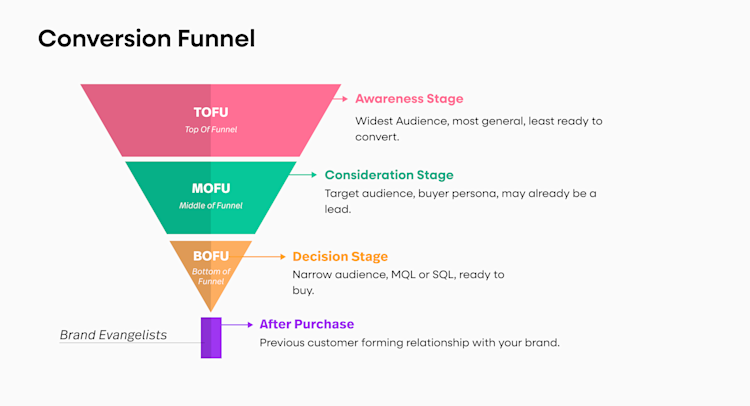
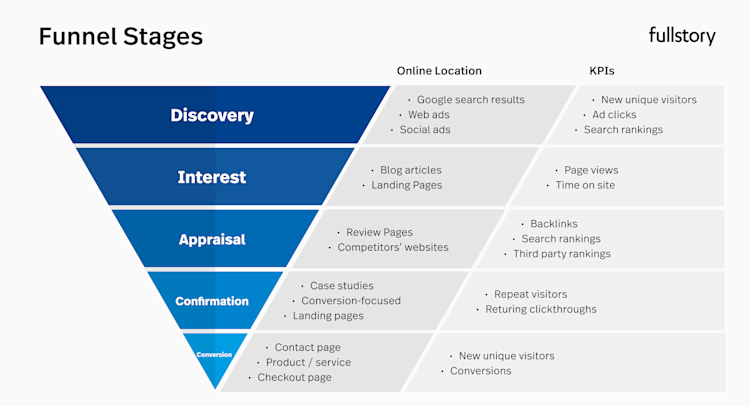

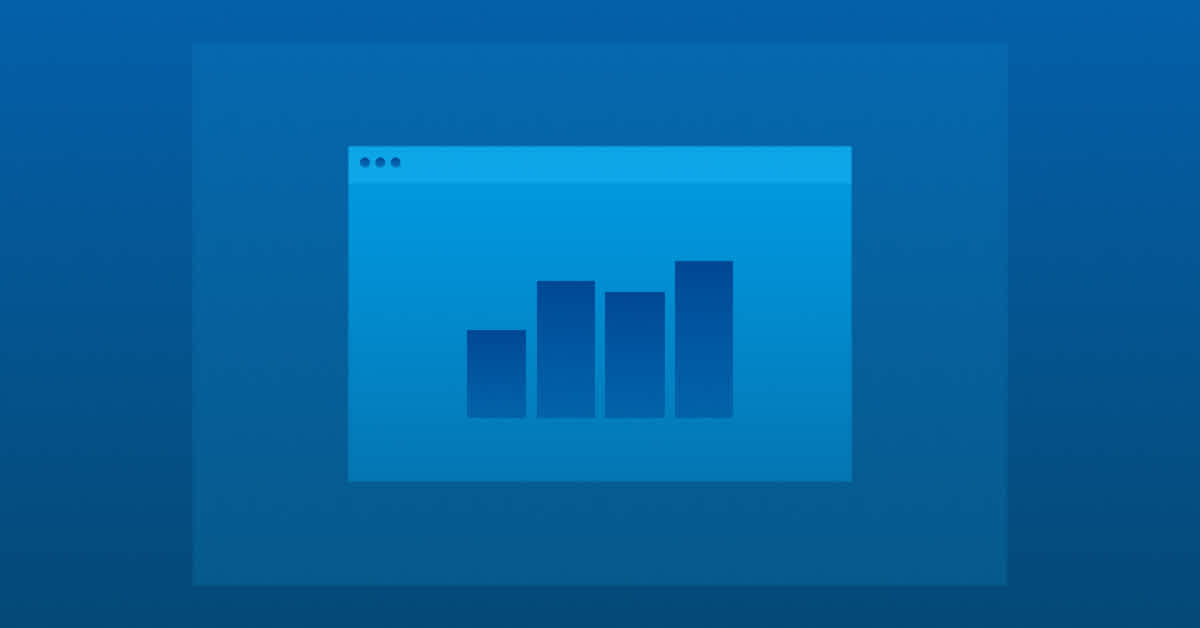

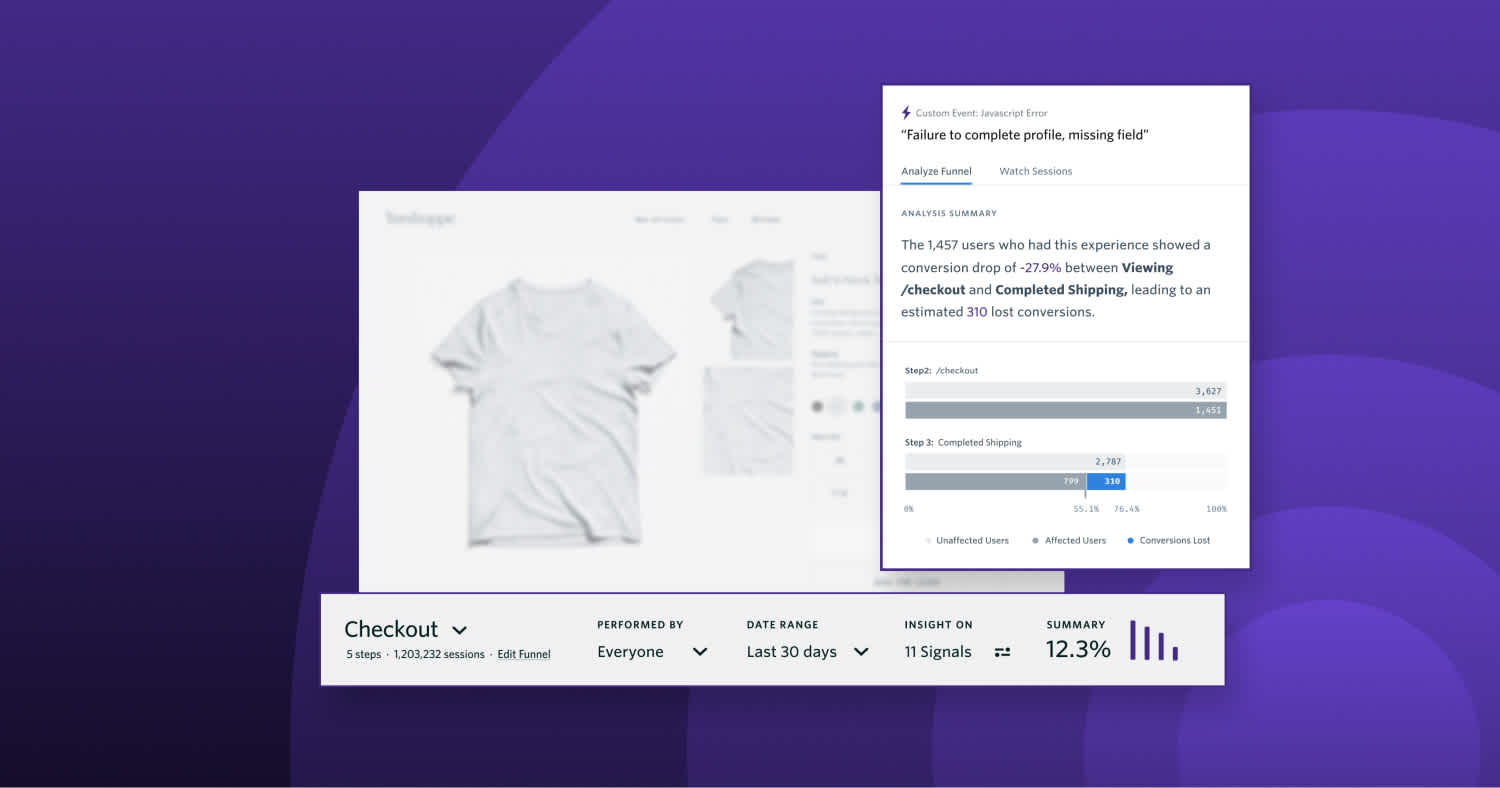
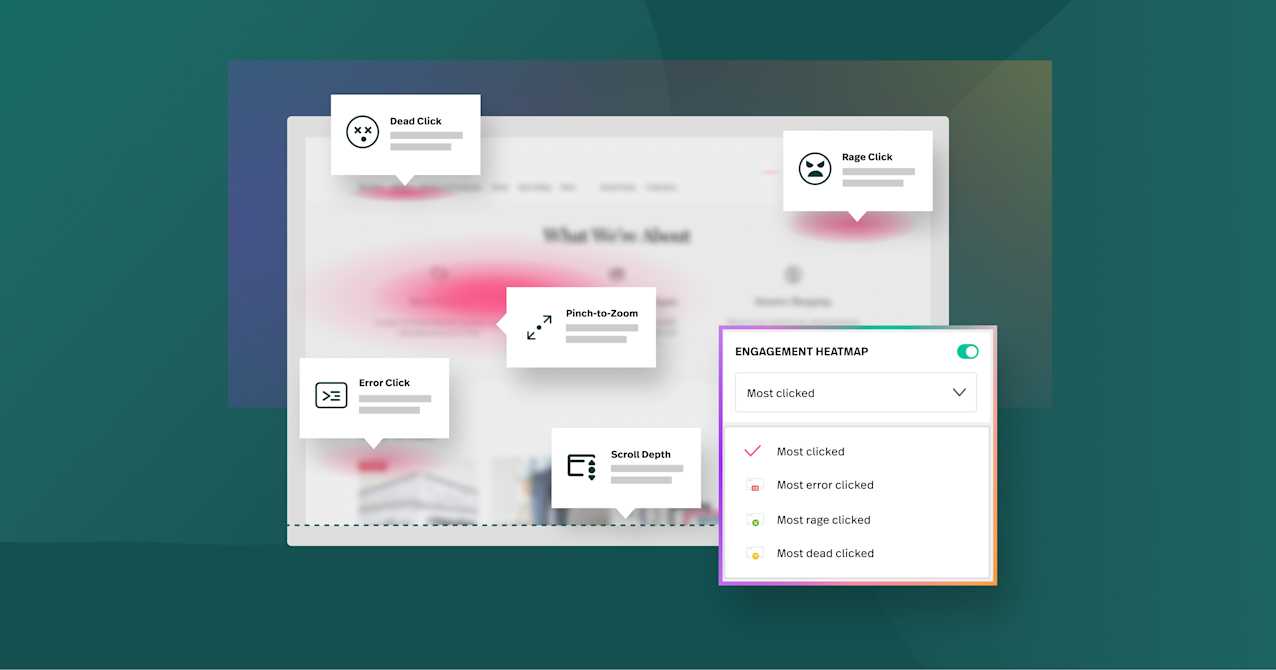
![[Blog] What is conversion rate optimization?](https://images.ctfassets.net/dkgr2j75jrom/nghhPHC4qtwZn8vXWN8jf/26a7b1a95ec663d6d49939f8498d161c/fs-pillar-page-CRO-og.jpg?w=1701&h=894&fl=progressive&q=50&fm=jpg&bg=transparent)